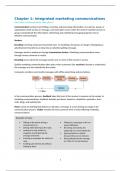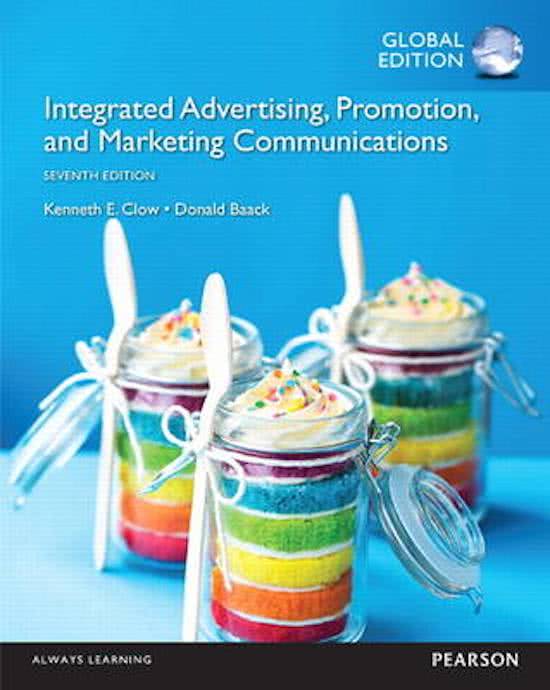Chapter 1: integrated marketing communications
How does communicati on take place?
Communication involves transmitting, receiving, and processing information. As a person, group, or
organization sends an idea or message, communication occurs when the receiver (another person or
group) comprehends the information. Advertising and marketing messaging programs rely on
effective communication.
Senders.
Encoding is forming verbal and nonverbal clues. In marketing, the person in charge of designing an
advertisement transforms an idea into an attention-getting message.
Messages travel to audiences through transmission devices. Marketing communications move
through various channels or media.
Decoding occurs when the message reaches one or more of the receiver’s senses.
Quality marketing communication takes place when customers (the receivers) decode or understand
the message as it was intended by the sender.
Companies combine social media messages with offline advertising and promotions.
In the communication process, feedback takes the form of the receiver’s response to the sender. In
marketing communications, feedback includes purchases, inquiries, complaints, questions, store
visits, blogs, and website hits.
Noise consist of anything that distorts or disrupts a message. It occurs during any stage in the
communication process. Clutter remains the most common form of noise affecting marketing
communications.
Examples of noise:
Talking on the phone during a Talking to a passenger as the car
commercial on tv. passes billboards.
Driving while listening to the radio. Becoming annoyed by ads
Looking at a sexy model in a appearing on a social media site.
magazine ad and ignoring the Ignoring tweets on twitter
message and brand. because they are not relevant.
Scanning a newspaper for articles to Being offended by the message
read. on a flyer for a local business.
Scrolling past internet ads without
looking at them.
1
, Using the same tagline and theme on all channels transmits a universal message to consumers. A
stronger brand presence becomes the result.
The marketing professionals involved in the communication process pay attention to each aspect of
the communications model to ensure that every audience member encounters a consistent message.
Common objectives marketing teams seek to achieve include an increase in market share, sales, and
brand loyalty.
An effective program integrates all marketing activities and develops high speed interactions with
consumers through a variety of mobile devices.
What is an integrated marketi ng communicati ons program?
Integrated marketing communications (IMC) is the coordination and integration of all marketing
communications tools, avenues, and sources in a company into a seamless program designed to
maximize the impact on costumers and other stakeholders. The program covers all of a firm’s
business-to-business, market channel, customer-focused, and internally-directed communications.
The marketing mix, which consists of products, prices, distribution systems, and promotions, is the
starting point. Traditional promotional activities include advertising, sales promotions, and personal
selling activities. Companies incorporate digital and mobile marketing, social media, and alternative
methods of communication into the program. The marketing mix requires additional activities
including database marketing, direct response marketing, personal selling tactics, sponsorships, and
public relations programs.
A complete IMC plan combines the elements of the marketing mix: products, prices, distribution
methods, and promotions.
A strategic marketing plan forms the basis for integrated marketing communications. The plan
coordinates the components of the marketing mix to achieve harmony in the messages and
promotions relayed to customers and others. Here are the steps of a marketing plan:
2





